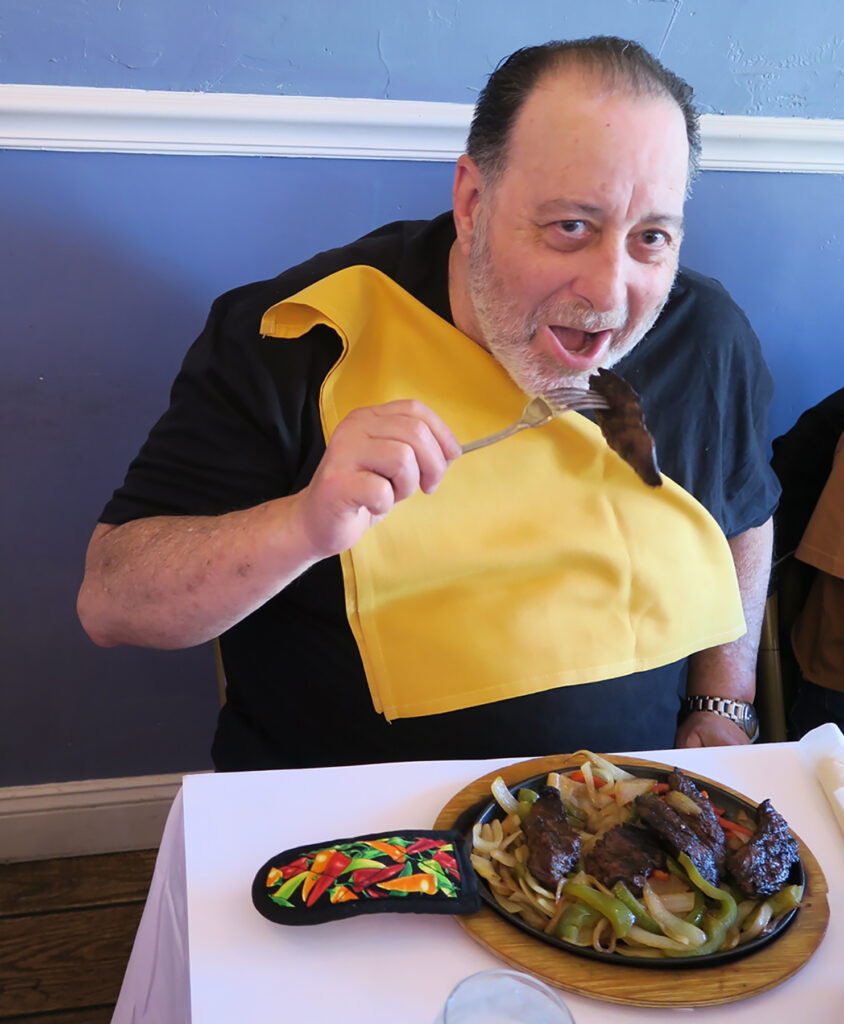Courtesy of RAF
Everyone loves fajitas.
They’re yummy, fun-to-eat, and come with sizzling stories. Most people know that fajitas are an authentic Mexican dish.
Wrong.
Step back to the 1930s and Texas ranchlands. During cattle roundups, wrote Virginia Wood in the Austin Chronicle, “beef was butchered regularly to feed the hands.” Vaqueros – Mexican cowboys – were often partially paid with “throwaway” parts that didn’t sell, like meat trimmings, entrails, and skirt steak.
Skirt steak? Yes – in those days it was considered “undesirable.” Today it sells for as much as $18 per pound.
Many of the first Tex-Mex dishes came from these creative vaqueros – like fajitas. They took strips of skirt steak, pounded thin, marinated, and grilled over the campfire. Everything was wrapped in a tortilla, often with grilled onions, peppers, and spices.
Can you taste the smoky results?
Slowly, the recipe spread, showing up in rodeos and outdoor festivals. No one could resist the sizzle.
In 1969, Emily Sorrow reported in The Local Palate, that a poor widow, Mama Ninfa (María Ninfa Rodríguez Laurenzo) was struggling to make ends meet. Mama grew up in the Rio Grande Valley, eating vaquero-style food. Her husband passed away and left her with five children to feed and a struggling tortilla factory. To stay afloat, Mama took the front of her Houston tortilla factory and opened a 10-table restaurant serving the old vaquero dish. Mama called it tacos a la ninfa or “build your own fajitas.” They were fast, portable, and you could eat it with your hands.
It was a hit!
Around the same time, a butcher named Sonny Falcon was experimenting with traditional foods. He grilled skirt steak wrapped in bacon and rolled in a tortilla. Falcon was the first to set up commercial fajita concessions at festivals and rodeos. Unlike most chefs, he cooked everything in view of the customers so they could watch what he was doing. Like Mama Ninfa, they were a huge hit wherever he went.
A local paper nicknamed Falcon the “Fajita King.”
Local restaurants caught on. Many added sizzling fajitas to their menus.
The Round Up Restaurant in the Rio Grande Valley changed things. Wood reported that in the 1980s they served fajitas “with warm flour tortillas and mounds of condiments like guacamole, pico de gallo, and grated cheese.”
Fajitas became the star of many menus.
George Weidmann, a German-born chef, recognized the popularity of fajitas. As head chef at the La Vista Restaurant in the Austin Hyatt Regency (Texas), he put “sizzling fajitas” on the menu. Weidmann used a tender cut of sirloin and eventually chicken, shrimp, and pork. It quickly became their signature dish, making LaVista the most popular restaurant in the chain, serving 13,000 fajitas a month.
The latest breakthrough in fajita history came with Chili’s, a popular restaurant chain. “Chili’s,” wrote Craig Hlauvarty in the Houston Chronicle, “introduced the dish to people in middle America and beyond (nearly 1,6000 locations).” He described the “fajita effect” – “when one diner receives their plate of loud, steaming fajitas, a few more orders are surely soon to follow.”
Today Chili’s reports that they sell over 60 million pounds of fajitas a year.
That’s a lot of sizzle.
Fajitas had their growing pains as well.
In 2002, fajitagate hit the news. Two off-duty San Francisco police officers beat two men without justification in an argument over a bag of takeout fajitas.
Interesting law enforcement.
Civil court jurors awarded the victims $41,000. The officers were acquitted. No surprise. One of them was the son of the Police Department’s Assistant Chief. Anderson Cooper commented, “when all is said and done, and the fajita was unraveled, and it grew cold, a lot of the charges ended up being dropped.”
Years later, according to AppleEats, Gilberto Escaramilla, a juvenile justice employee, “would intercept county-funded food deliveries and deliver them to his own customers.” AppleEats estimated that he stole the fixings for about 80,000 fajitas.
None of this stopped the celebration of National Fajita Day in August or fajitas appearing on TV shows like Friends; movies like Chef and Cloudy With a Chance of Meatballs2; and videogames like Overcooked.
Today you can make-your-own fajitas, get them from stands, food trucks, frozen, and in some of the finest Tex-Mex restaurants. There are over 1,000 Amazon books about fajitas, along with special fajita skillets, toys, puzzles, and costumes.
Fajitas continue to evolve into regional versions, burritos-style, and fajita bowls. You can get everything from the traditional and vegetarian to a chef’s invention.
Bobby Flay said it best. “Fajitas are like a dance of flavors on your tongue.”
Enjoy!







Wonderful! We love fajitas too! But then, who doesn’t? We laughed at the “fajita effect”…it’s so true! We’ve done it ourselves; watched a sizzling fajita order go by our table and suddenly our decision of what to order is made for us. Great article and great photos by RAF: thanks again for another fun and educational read. Now I’m hungry for fajitas!
Hey, I know some people in this post. Fajitas was a favorite of my father. Chilis did sorta, kinda brought tex-mex Mexican to the masses. For me, it was a date night destination in high school.